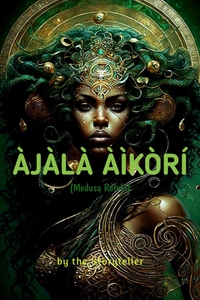
Once upon a time in Ile-Ife, when gods and goddesses lived among men, there lived a maiden, the most beautiful of all. She was Àjàlà Òrìsà, and her beauty was captivating and mesmerizing; one couldn't pass her by without stopping to take a second look.
Àjàlà Òrìsà was the third child of the sea spirits, Egùngùn and Erinle. She was the only mortal among her sisters, Ìyàwò Ókè and Àròkè Àjè. Àjàlà was adored and admired by gods, goddesses, men, and even women. Her beauty was unmatched and unequaled in the whole tribe.
Thousands of gods, goddesses, spirits, deities, and mortals flocked around the sea, seeking Àjàlà’s hand in marriage, but she rejected them all. She was envied by many women, some of whom prayed to the gods to make them as beautiful as Àjàlà. However, Àjàlà had fallen in love with Òlòkun, the Supreme ruler of the ocean, who was engaged to be married to her sister, Ìyàwò Ókè. Àjàlà met the Supreme ruler one fine morning while visiting her family in the sea. She stumbled upon the sea god as he was patrolling, and they were immediately drawn to each other. Swayed by her beauty, the sea god wanted to wed her, but he was already engaged. Thus, they began an illicit affair behind her sister's back.
Àjàlà Òrìsà and Òlòkun became so attracted to each other that the sea god swore to make her his concubine, but Àjàlà Òrìsà rejected his proposal. She claimed she was too beautiful to end up as his concubine and insisted on becoming his wife instead. Blinded by Àjàlà’s beauty and lust, Òlòkun decided to break off his engagement with her sister. Ìyàwò Ókè, devastated by the news, locked herself away and wept for days. Curious as to why the sea god had suddenly broken their long-standing engagement, she began to investigate. During this time, Òlòkun and Àjàlà Òrìsà secretly planned their marriage.
When Ìyàwò Ókè discovered her sister’s betrayal, she became enraged. In revenge, Ìyàwò Ókè transformed her sister into a monstrous creature. Àjàlà’s beautiful hair turned into venomous snakes, and her gaze became petrifying. Her face contorted into a grotesque appearance, with bulging eyes and a twisted grin. When the news of Àjàlà’s transformation reached the sea god, he felt guilty but did not intervene or attempt to reverse Ìyàwò Ókè’s curse. Instead, he distanced himself from her, refusing to acknowledge their past relationship.
Àjàlà became a solitary figure, feared and avoided by all. She was no longer referred to as Àjàlà Òrìsà but as Àjàlà Àìkòrí, meaning “The Gazer who Petrifies.” Her deadly gaze could turn people to stone. She lost her connections with family, friends, and society. Àjàlà suffered immense emotional pain, regret, and self-loathing. Her former identity was erased by her transformation, and she became a creature stripped of her mortal qualities. Embarrassed and ashamed, Àjàlà fled to the forest to live out her remaining days as a monster. She dwelled in a mountain, surrounded by snakes and other creatures, avoiding human interaction.
Àjàlà avoided mirrors, lakes, and other reflective surfaces, fearing her own monstrous appearance. Despite her isolation, Àjàlà became pregnant with Òlòkun’s offspring. Her monstrous form made her a target for heroes. Warriors, hunters, and priests all sought to kill her, but they did not succeed. Àjàlà’s presence in the forest became a formidable barrier, protecting the forest's interior from intruders. This greatly affected the people of Ile-Ife, especially the hunters and high priests, who could no longer venture deep into the forest for hunting or searching for herbs.
King Orange of Ile-Ife was greatly disturbed by the monstrous creature Àjàlà Àìkòrí, as she was now called, who lurked in the forest. So he sent Ogun, the god of iron, war, and technology, to bring back Àjàlà’s head. Before Ogun headed to the forest, he visited Ifa (god of divination and wisdom) and Eshu (god of crossroads and messenger) to fortify himself. Ifa provided strategic advice and guidance to Ogun, lending him his Agbada Oro, a sacred garment worn by Ifa, granting him spiritual protection and invisibility. Ifa also gave him an Iyere, a magical mirror, to let him gaze at Àjàlà indirectly.
Eshu, on the other hand, offered to accompany Ogun part of the way and provided him with his feathered cap to allow him to fly. Eshu also gave him a sickle-shaped sword (Ogbun Oye) to behead Àjàlà. On his journey, Ogun encountered Osun and her sisters, seeking their guidance. He performed sacrificial rites to appease them, and in return, they revealed Àjàlà’s exact location and gave him a magical pouch (Kibisis) to store Àjàlà’s head. Ogun thanked them and continued on his journey. Before reaching the mountain where Àjàlà lived, he met Iya Mopo, an ancient sea goddess. Ogun tried to get information from her but was unsuccessful, so he stole her eyes and tooth, forcing the sea goddess to reveal Àjàlà’s secret: her weakness was Aja, a magical bird’s feather, and she resided in Igbo-Elu, the sacred forest.
Armed with this knowledge and magical tools, Ogun marched fearlessly to Àjàlà’s lair. When he reached Àjàlà’s lair, hidden within Igbo-Elu, Ogun wore the Agbada Ori and carried the Ogbun Oye. Àjàlà, surrounded by snakes and darkness, gazed menacingly, her stare capable of petrifying even the bravest warriors. Ogun, looking at Àjàlà’s reflection in the Iyere provided by Ifa, approached her without making direct eye contact. With a swift strike, Ogun used the Ogbun Oye to behead Àjàlà. From Àjàlà’s severed head, the winged horse Akoko and the giant Ogbin emerged.
Ogun carefully placed Àjàlà’s head in the Kibisis, escaping the lair while overcoming various challenges and obstacles. He returned to his kingdom victorious, presenting Àjàlà’s head to King Orange, solidifying his reputation. The people of Ile-Ife rejoiced, and King Orange threw a grand feast to celebrate their triumph over chaos.
Loading comments...

